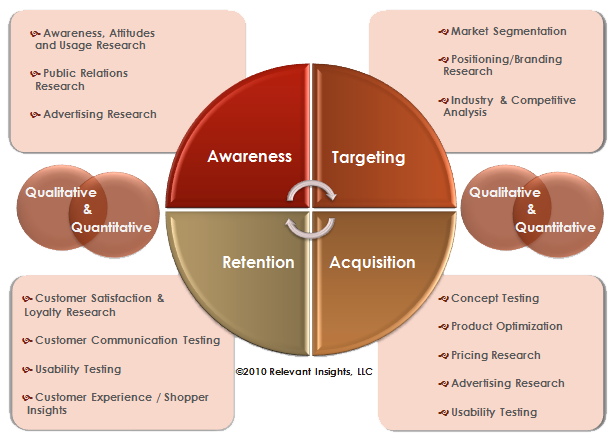
There are many different types of market research that cover various areas of study, and as a result are often misunderstood.
Whether you’re interested in learning more about your customer’s buying habits or how much they might pay for a new product, market research can help (if you use it correctly).
To help you identify which type of market research is right for you, we’re going to outline the different types, their purposes, and when to use each one.
Common Types of Market Research
By “types of research” I don’t necessarily mean how you’re collecting data. Instead I mean the procedures and methodology used to analyze the data collected.
These procedures include market segmentation, product testing, advertising testing, key driver analysis for satisfaction and loyalty, usability testing, awareness and usage research, and pricing research (using techniques such as conjoint analysis), among others.
Market Segmentation
When conducting market segmentation studies we’re generally asking survey questions aimed at capturing needs, values, attitudes, behaviors and demographics. A B2B company might also want to investigate firmographic data such as company size, revenues, and product category that are relevant to the industry in question.
Marketing can’t effectively speak to every type of person or business at the same time, so one of the main goals of market segmentation is to allow for more efficient and effective marketing tactics.
Without market segmentation companies are shooting in the dark and wasting valuable bullets. They may hit a customer by accident, but they would miss a lot of others.
Product Testing
A detailed understanding of how your product meets (or doesn’t meet) your customer’s needs is crucial both to product development and marketing, so these types of market research studies need to be conducted throughout a product’s life.
Ultimately you should be able to make informed “go” or “not go” decisions about new features and products before launch, and thus save capital, time and effort.
Successful product testing should:
- Give insight into product/service viability by investigating competing and substitute alternatives along side customers’ willingness to embrace new products/services.
- Determine competitive advantage as well as possible threats from similar products/services.
- Identify the products with the highest revenue potential.
- Clarify what improvements should be prioritized before a product launch (or re-launch).
- Pinpoint which product features (both existing and potential) are most important to your target audience.
- Help produce marketing messages to change or enhance existing perceptions about your products/services.
Advertising Testing
Like product testing, tests of your advertising campaigns can save you valuable time and resources. By taking potential campaigns directly to your audience and gauging their response you can focus on creating truly impactful advertising.
Satisfaction and Loyalty Analysis
Satisfied customers aren’t necessarily loyal customers, but consistently measuring customer satisfaction is a great way to increase customer retention.
This type of research is aimed at identifying key drivers of satisfaction and measuring the likelihood of customers to continue using a company’s products and services.
The goals of these kinds of studies are:
- Determine what factors influence loyalty, advocacy, and repeat purchases, including product/service attributes, company operation, customer service, price, etc.
- Carefully monitor overall satisfaction, recommendation likelihood, and defection likelihood over time.
- Provide early warnings about emerging gaps in product/service performance, customer service, and processes that might lead to customer defection.
- Help identify areas of the product or service that need improvement to meet changing needs.
- Guide the creation and/or ongoing development of customer loyalty and retention programs.
- Signal when organizational changes need to be made to improve operations and customer retention.
Brand Awareness and Reach
By conducting regular, well-designed brand awareness surveys you can keep tabs on how effective your marketing campaigns really are.
When done right, a brand awareness survey can help you measure:
- Brand Recall: Can a customer spontaneously recall your brand, or do they think first of a competitor?
- Brand Recognition: When presented with a list of brands, does your audience recognize yours as a reputable option?
- Brand Identity: Brand identity is what you as a marketing team create. It’s important to determine whether these efforts are being successful.
- Brand Image: While brand identity is created by the brand itself, a brand’s image is based in the customer’s perception alone. Tracking disparities in these two can reveal gaps in your marketing efforts.
- Brand Trust: In an era of data breaches, keeping tabs on your levels of brand trust is key. If your brand doesn’t appear trustworthy, you will have difficulty retaining customers.
- Brand Loyalty: Loyal customers can become evangelists, but you need to consistently track loyalty levels to determine how often this transformation is happening.
- Customer Profile: Changes in your core customer base may signal the need for a pivot, either in the product or your marketing messages (or both).
For more on starting your own brand awareness initiative, see our guide on these critical marketing surveys.
Pricing Research
Surveys that ask customers to choose between different products with unique features and price points, typically done via conjoint analysis, can help you identify what features are most valuable to your audience and what they’d be willing to pay for them.
Combined with some basic research on your competitors’ pricing, these insights can give you a distinct advantage in pricing your products and services.
Knowing Which Type of Research to Use
When to use each of these different types of market research data collection methods and types of research depends on the business issues we are dealing with in one or more of four key areas:
- Awareness: let the market know that the product or service exists
- Targeting: reach the target segments with the highest profit potential
- Acquisition: optimize the marketing message, offer, and price that will close the sale
- Retention: generate repeat purchases from current customers
The chart below, which we call the Relevant Wheel, shows when it is most appropriate and relevant to conduct different types of research.

Our clients at Relevant Insights often use this chart as a reference to determine when a particular type of research is needed. Once this is defined, we then discuss the most appropriate qualitative or quantitative data collection methods.
Data Collection and Analysis Methods
Here we need to make a distinction between data collection methods and market research types based on analytical approach, which are often confused. Data collection methods differ based on whether we want to conduct quantitative or qualitative research.
Qualitative research, which is exploratory in nature, usually uses data collection methods such as focus groups, triads, dyads, in-depth interviews, uninterrupted observation, bulletin boards, and ethnographic participation/observation.
Quantitative research, which looks to quantify a problem, collects data through surveys in different modalities (online, phone, paper), audits, points of purchase (purchase transactions), and click-streams.
Choose the Market Research Type that Meets Your Needs
Next time you wonder what type of market research to conduct, I invite you to ask yourself where the particular problem at hand belongs: Awareness, Targeting, Acquisition or Retention. Then take a look at the Relevance Wheel to find the approach that will help you answer your specific questions.
If you choose your method carefully market research can give you a big advantage over your competition.